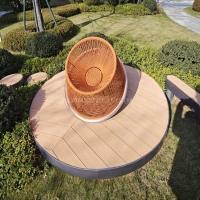Welcome to the website for landscape facilities products and knowledge.
What are the most common design flaws in landscape bar counters and how can they be avoided?
Landscape bar counters serve as beautiful focal points in outdoor entertainment areas, yet many homeowners and designers encounter preventable design flaws that compromise both functionality and aesthetics. Understanding these common mistakes is crucial for creating spaces that truly enhance outdoor living experiences.
One significant flaw involves inadequate counter overhang. Many outdoor bars feature insufficient overhang, typically less than 10-12 inches, which fails to provide comfortable legroom for seated guests. This oversight creates uncomfortable seating arrangements where guests' knees constantly bump against solid surfaces. The solution lies in planning for at least 12-15 inches of overhang, allowing ample space for comfortable seating while maintaining structural integrity.
Poor drainage represents another critical oversight. Landscape bars exposed to weather elements require carefully integrated drainage systems. Without proper slope planning (minimum 1-2% gradient) and drainage channels, water accumulates on counter surfaces, leading to staining, material degradation, and potential structural damage. Incorporating discreet drainage grooves along the counter's edge and selecting materials with low water absorption rates can effectively address this issue.
Insufficient storage planning often diminishes practicality. Many outdoor bars feature beautiful counters but lack integrated storage for essential items like glassware, bar tools, and cleaning supplies. This forces homeowners to constantly transport items between indoor and outdoor spaces. Incorporating lockable cabinets, insulated compartments, and dedicated spaces for ice buckets and refrigeration units significantly enhances functionality.
Improper material selection remains a prevalent mistake. Designers often choose materials based solely on aesthetics without considering weather resistance, maintenance requirements, and thermal properties. Materials like untreated wood warp and crack, while dark stone surfaces become unbearably hot in direct sunlight. Selecting materials specifically rated for outdoor use, with appropriate texture and heat-reflective properties, ensures longevity and comfort.
Inadequate lighting undermines both ambiance and functionality. Many landscape bars rely solely on overhead lighting, creating harsh shadows and insufficient task illumination for drink preparation. Layered lighting solutions—incorporating overhead fixtures, under-counter LED strips, and pathway lighting—create both practical workspaces and inviting atmospheres for evening entertainment.
Poor traffic flow planning leads to congested spaces. Bars designed without clear separation between preparation, serving, and socializing areas create chaotic environments during gatherings. Implementing the "work triangle" concept—efficient positioning between storage, preparation, and serving areas—while maintaining clear pathways significantly improves user experience for both hosts and guests.
Finally, neglecting weather protection compromises year-round usability. Bars designed without consideration for sun exposure, wind patterns, or precipitation become unusable during various weather conditions. Incorporating strategic elements like pergolas, retractable awnings, or windbreaks extends seasonal usability while protecting both guests and bar surfaces from element-related damage.
By addressing these common design flaws through careful planning, appropriate material selection, and thoughtful consideration of human factors, homeowners can create landscape bar counters that seamlessly blend beauty with functionality, ultimately enhancing their outdoor living spaces for years to come.
Related search:

Recommendation
Swivel chair-Specialty steel structure woven rattan leisure chair with rotatable design